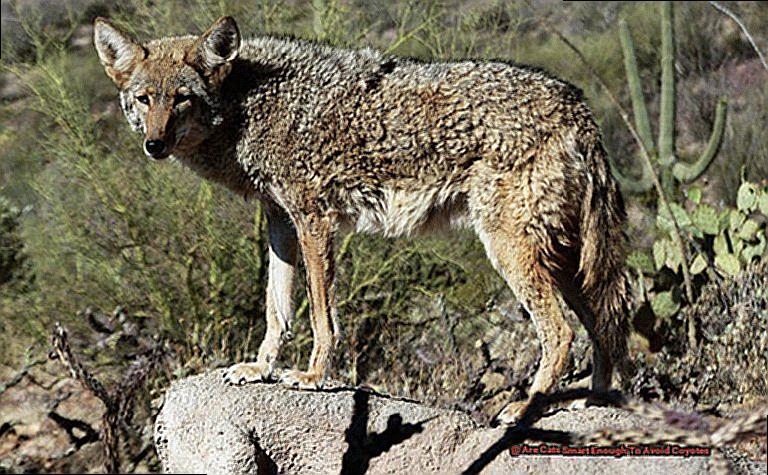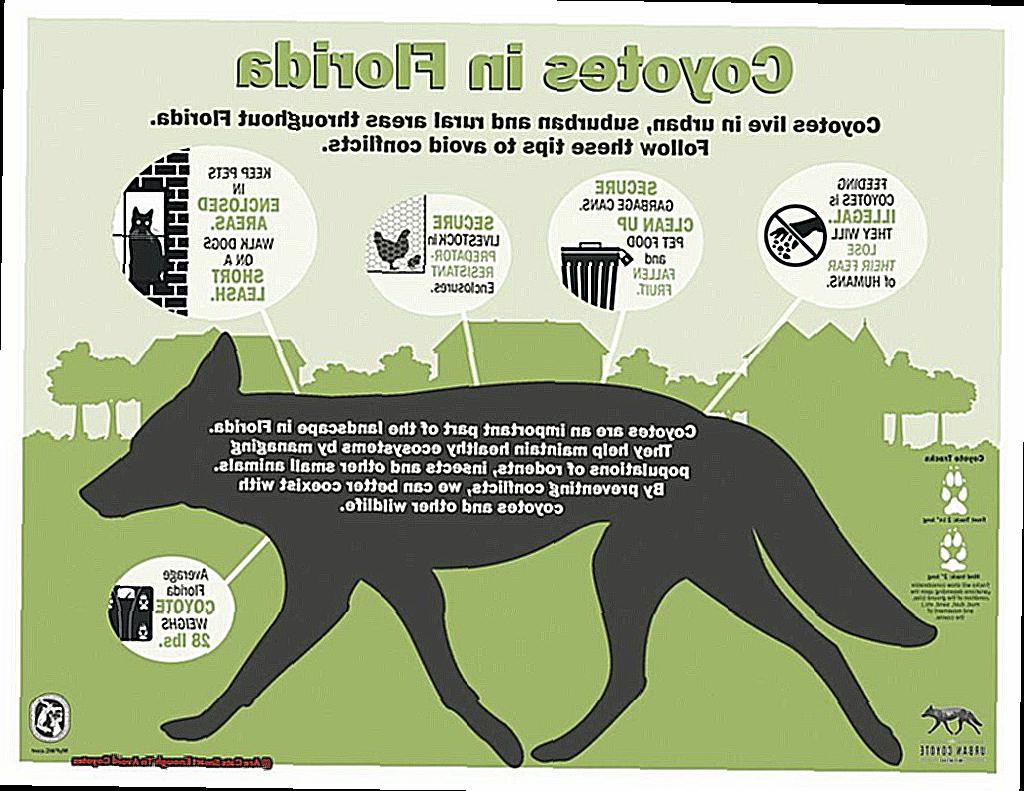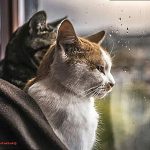While curled up on your lap, your cat may look like the most skilled survivor ever.
But can their smarts and skills really save them when they’re in danger from a coyote? People who own cats and people who study animals have had heated debates about this question.
Some people swear that their cats are smart, while others say that the smart fox is smarter than their cats. We’ll look into the world of cats’ intelligence and behavior in this blog post to see if our beloved pets are smart enough to beat these dangerous pests.
Let’s settle down with your pet friend and figure out this interesting puzzle together.
Are Cats Smart Enough To Avoid Coyotes?
Contents
Cats are born with natural instincts to hunt and defend themselves. These instincts have helped them survive in the wild for thousands of years. Cats are intelligent creatures. They can adapt to their surroundings. They stalk their prey. They also hide from potential danger.
However, when faced with a coyote, a cat’s instincts may not always be enough. Coyotes are opportunistic predators and will attack smaller animals if given the chance. Plus, these elusive creatures can be found in both urban and rural areas, making it difficult for cat owners to avoid them.
There are ways that cats use their natural instincts and behaviors to avoid coyotes. Let’s take a closer look.
Climbing:
One of the most well-known abilities of cats is their excellent climbing skills. When faced with danger, cats can quickly escape by climbing trees, fences, or other high places. This is why providing your outdoor cat with high perches or cat trees can be beneficial.
Hiding:
Cats are also masters at hiding in small spaces or blending into their surroundings. This serves as an advantage when trying to avoid a coyote. However, it’s important for cat owners to make sure their outdoor environment has plenty of hiding spots for their feline friends.
Grouping Together:
Some cats may form colonies or groups for protection against predators like coyotes. This is especially common in feral cat colonies where they can rely on each other for safety.
Communication:
Cats use vocalizations and body language to communicate with each other, allowing them to warn each other of potential danger. As a cat owner, it’s important to pay attention to your cat’s behavior and vocalizations, as they may be trying to warn you of a coyote’s presence.
Understanding the Threat of Coyotes to Cats
There is a potential threat lurking outside that you may not be aware of – coyotes. Adaptable predators prey on small animals, including cats. Pet owners worry about them.
We will explore coyotes and their danger to cats in this section. You will gain valuable knowledge to protect your pet.
The Facts
Let’s start with some facts about coyotes. These predators are prevalent in many parts of North America, including urban areas. They are skilled hunters and opportunistic eaters, meaning they will take advantage of any available food source.
This includes small pets like cats. In fact, according to the National Park Service, coyotes have a diverse diet and can easily take down a cat if given the opportunity.
Adaptability and Intelligence
One of the reasons why coyotes are such a threat to cats is their adaptability and intelligence. They can thrive in both rural and urban environments, making it difficult to avoid them. They have been known to live in parks, golf courses, and even residential neighborhoods.
Furthermore, coyotes are intelligent and can easily outsmart traditional methods of keeping them away from homes and pets. They can jump over fences or dig under them, leaving your cat vulnerable to attack.
The Importance of Awareness
It is crucial for cat owners to be aware of the potential threat that coyotes pose to their pets. Knowing that these predators are present in your area allows you to take necessary precautions to keep your cat safe.
Some may argue that cats are smart enough to avoid coyotes on their own. While cats are agile and quick, they may not always be aware of the potential danger posed by a coyote.
They may also be too curious or confident in their own abilities, leading them to venture into areas where coyotes may be present.
Other Dangers

A cat might avoid a coyote, but face other dangers. It could get hit by a car or lost while escaping. It is essential for cat owners to understand the potential risks and take necessary precautions to protect their pets.
Factors That Affect a Cat’s Ability to Avoid Coyotes
As cat owners, we all want to keep our feline companions safe from harm. One of the biggest threats to our cats, especially those who love to roam outside, are coyotes.
These adaptable predators are skilled hunters and have been known to prey on small animals like cats. But what factors can impact a cat’s ability to avoid coyotes?
Let’s take a closer look at some of the key factors.
Natural Instincts
Cats have a natural instinct to hunt and protect themselves. They are agile and quick, which allows them to escape potential predators. However, this instinct may vary among individual cats, depending on their breed and upbringing.
Outdoor cats may be more skilled at avoiding coyotes than indoor cats. Indoor cats may have less experience with potential dangers.
Age and Health
Another factor that can affect a cat’s ability to avoid coyotes is their age and health. Younger and healthier cats may have better chances of avoiding coyotes compared to older or sickly ones. This is because they have more energy and can move faster if needed.
Older cats may also have impaired senses, making it harder for them to detect coyotes. Additionally, cats with health conditions may not be as agile or quick, making them an easier target for coyotes.
Environment
The environment in which a cat lives also plays a significant role in their ability to avoid coyotes. Cats in rural or suburban areas may encounter coyotes more often.
This is because there is more wildlife and open space.
In contrast, cats in urban areas have less chance of encountering coyotes. This is because coyotes tend to thrive in these types of environments and are more likely to come into contact with domestic animals.
Human Intervention
Believe it or not, human intervention can also affect a cat’s ability to avoid coyotes. If an owner regularly feeds their cat outside, it increases the chances of attracting coyotes as well. Human activity like construction or development disrupts the natural habitats. This can increase interactions between cats and coyotes.
Natural Instincts That Help Cats Avoid Danger
Cats are known for their agility, intelligence, and natural instincts that help them avoid danger. Coyotes pose a major threat to outdoor cats. Your feline’s instincts protect them from these predators. In this post, we’ll explore how cats’ natural instincts help them outsmart coyotes.
Sharp Hearing and Vision
Cats have exceptional hearing and vision, which are crucial for their survival. They can hear high-frequency sounds that humans can’t, making them more aware of their surroundings. This heightened sense of hearing allows them to detect the sounds of potential predators like coyotes in the distance.
Similarly, cats have excellent vision, especially in low light conditions. This gives them the ability to spot potential threats from a distance, giving them enough time to escape or hide. Their sharp vision also helps them navigate through their environment and avoid any potential dangers.
Strong Sense of Smell
Aside from their senses of hearing and vision, cats also have a strong sense of smell. They can pick up scents that humans cannot, allowing them to identify any nearby predators and avoid them. This ability comes in handy when a cat is exploring unfamiliar territory.
Agility and Quick Reflexes
Cats are known for their agility and quick reflexes, which are vital in avoiding predators like coyotes. Their ability to climb and jump allows them to escape danger by climbing up trees or jumping onto high surfaces that may be inaccessible to predators. Additionally, their quick reflexes help them run, dodge, and change direction quickly, making it challenging for predators to catch them.
Hiding and Camouflaging Skills
Cats are skilled at blending into their surroundings, making it difficult for predators like coyotes to spot them. They can use their natural camouflage to hide in bushes or undergrowth, keeping themselves safe from harm. This ability to hide and blend in with their environment is a crucial instinct that helps cats avoid danger.
Cautious Behavior
Cats are naturally cautious animals and tend to avoid unfamiliar or potentially dangerous situations. They are good at assessing risk and will often retreat if they sense any potential danger. This cautious behavior is a crucial instinct that helps cats stay safe from predators like coyotes.
Precautions for Cat Owners to Keep Their Pets Safe from Coyotes
As much as we love our feline friends, it’s important to be aware of the potential dangers lurking in the great outdoors. One of the biggest threats to our furry companions is the presence of coyotes in our neighborhoods. These predators are known for their cunning tactics and can pose a serious threat to our beloved pets.
So, what can we do to protect our cats from coyotes? As an expert on cat safety, I’ve gathered some valuable insights and precautions for all cat owners to consider.
Keep your cats indoors
The first and most crucial step in protecting your cats from coyotes is to keep them indoors. This eliminates any chance of an encounter with these predators and also keeps your cat safe from other outdoor dangers such as cars and diseases.
Supervise outdoor time
If you do choose to let your cat outside, it’s important to supervise them at all times. Cats may be intelligent animals, but they can’t always recognize coyotes as a threat and may approach them out of curiosity. Bringing your cat in before sunset, when coyotes are most active, is also a good precaution to take.
Make your yard unattractive to coyotes
Coyotes are attracted to easy food sources, so it’s important to keep potential food sources inside, such as pet food and bird feeders. Additionally, securing any potential entry points into your yard, like holes in fences or gaps under gates, can prevent coyotes from entering.
Carry deterrents while walking on a leash
If you walk your cat on a leash, it’s important to stay vigilant and carry a deterrent like a whistle or air horn in case of a coyote sighting. These loud noises can help scare off the predator and protect your cat.
Educate yourself about coyote behavior
Knowing what attracts coyotes and how they typically behave can help you take necessary precautions to protect your cat. For example, keeping your yard clean and free of debris can prevent coyotes from hiding and potentially attacking your cat.
Remain calm in case of a coyote sighting or attack
In the rare case that you encounter a coyote, it’s important to remain calm and not approach the animal. Making loud noises or throwing objects can help scare them off. If there is an attack, seek help from local authorities and report the incident.
How Different Cats React to Encountering a Coyote
These predators are common in many areas where cats reside and can pose a serious threat to their safety. But have you ever wondered how different cats may react in such a situation? As an expert on this topic, I have analyzed the factors that can influence a cat’s reaction when encountering a coyote. Here’s what you need to know to keep your furry friend safe.
Age Matters
Just like humans, cats’ physical abilities can change as they age. Older cats may not have the same quick reflexes and agility as younger cats, making them more vulnerable to a coyote attack. This is especially true for senior cats who may have mobility issues or health concerns. It is important for owners of older cats to be aware of this and take necessary precautions to keep them safe.
Breed Characteristics
Some breeds of cats may be more prone to certain behaviors and instincts compared to others. Breeds known for being laid-back may lack survival instincts.
Active breeds are more agile and alert, ensuring survival. Cat owners must understand their cat’s breed characteristics. They should adjust safety measures accordingly.
Previous Experiences
A cat’s past experiences with predators can also play a role in how they react when encountering a coyote. Cats that have never encountered a predator before may be more curious and less fearful, while cats that have had negative experiences with predators may be more cautious and avoid any potential danger. It is crucial for owners to observe their cat’s behavior and take note of any past incidents that may affect their reactions.
Indoor vs. Outdoor Cats
The living environment of a cat can also influence their reaction when encountering a coyote. Outdoor cats may be more familiar with their surroundings and potential predators, while indoor cats may not have the same awareness. It is important for owners to supervise their cat’s outdoor time and provide a safe and secure environment for them to explore.
The Importance of Responsible Pet Ownership in Protecting Cats from Coyotes
As an expert on responsible pet ownership, I cannot stress enough the crucial role it plays in keeping cats safe from coyotes. In this blog post, we will discuss the measures that cat owners can take to ensure their feline friends are protected from these natural predators.
Keeping Cats Indoors
The most effective way to protect cats from coyotes is by keeping them indoors. Not only does this prevent them from encountering potential predators, but it also keeps them safe from traffic and other dangers. Indoor cats also tend to live longer and healthier lives compared to outdoor cats.
Secure Outdoor Spaces
If letting cats roam outside is unavoidable, it is important to provide a secure outdoor space for them. This can be an enclosed patio or a “catio” – a designated outdoor area specifically designed for cats. These spaces allow cats to enjoy the outdoors while staying protected from predators.
Be Aware of Surroundings
Being aware of potential coyote habitats in your area is crucial in protecting your cats. Coyotes are most active at dawn and dusk, so it is important to keep a close eye on your cats during these times. Knowing where and when coyotes are most active can help you take extra precautions to keep your cats safe.
Properly Dispose of Food and Garbage
Coyotes are opportunistic hunters and will be drawn to areas with easy access to food. To avoid attracting them, it is important to properly dispose of food and garbage. Keep garbage cans securely closed and do not leave pet food outside.
Vaccinations and Spaying/Neutering
Responsible pet ownership involves taking preventative measures and keeping cats vaccinated. Additionally, it includes spaying or neutering them. Vaccinations shield cats from diseases transmitted by coyotes. Spaying/neutering controls stray and feral cat population, deterring coyotes. Coyotes are attracted to prey on vulnerable cats.
Conclusion
In conclusion, cat owners and experts have a lot to say about the question of whether cats are smart enough to beat foxes. Cats are known for being smart and able to stay alive, but can they really get away from these skilled hunters? We have learned more about this interesting subject by looking into the behavior and senses of cats.
As we learned, cats are born with natural abilities to hunt and protect themselves, but these may not be enough to protect them from a wolf. Cats are smarter than coyotes. They use natural habits like climbing, hiding, getting together, and talking to get away from them. As responsible pet owners, we need to know how dangerous coyotes are and take the right steps to keep our furry friends safe.
Several factors can impact a cat’s ability to avoid coyotes. These include age, health, surroundings, human interaction, training, and socialization. When a cat sees a wolf, it may respond in different ways depending on its age, breed, past events, living situation, and attitude.
In the end, sensible pet ownership is the best way to keep our cats safe from wolves. We can keep coyotes away by keeping them inside or providing safe outdoor spaces. It is important to be aware of potential risks in our environment. Additionally, disposing of food and trash properly is crucial. Getting them vaccinated and spayed or neutered on a regular basis is also very important for their safety.
As pet owners, let’s all do what we can to keep our furry friends safe from wolves.






